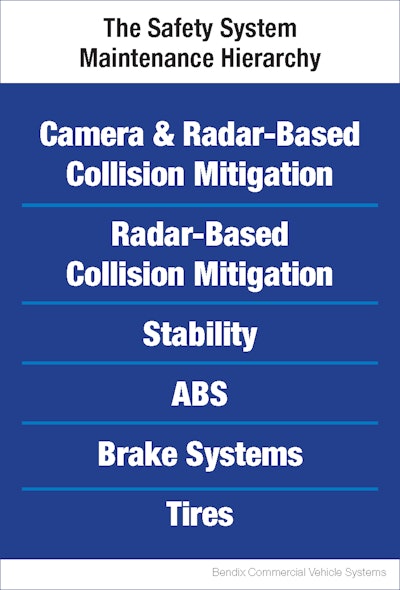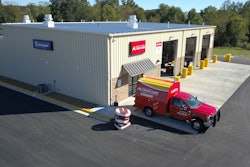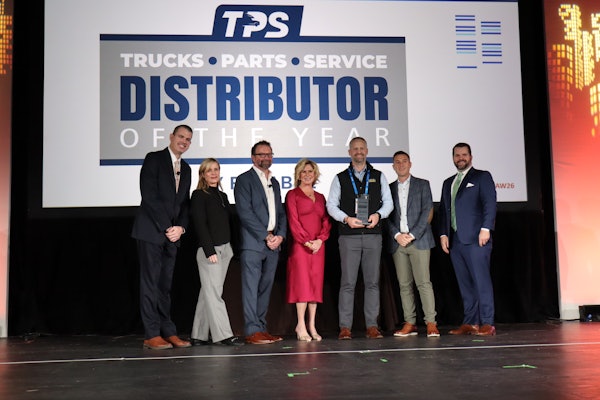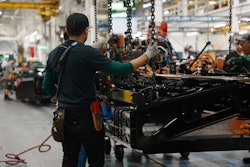
“Almost 9,400 vehicles received out-of-service (OOS) violations during Roadcheck 2017, and more than half of those – 56.5 percent – were related to tires or wheels and brakes: the two categories at the base of what we call the hierarchy of safety system maintenance,” says Fred Andersky, director of government and industry affairs at Bendix. “And if those aren’t maintained properly, you can’t expect the best performance out of a vehicle’s higher-level safety technologies, from antilock brakes to stability and collision mitigation.”
As North America’s leader in the development and manufacture of active safety, air management, and braking system technologies for commercial vehicles, Bendix says it offers insight on how fleets and owner-operators can both prepare for this year’s Roadcheck and establish best practices now that will strengthen safety down the road.
Over more than three decades, International Roadcheck – the largest targeted commercial motor vehicle program in the world – has involved more than 1.5 million total roadside inspections in the United States, Canada, and Mexico.
On average, the 72-hour period will see roughly 17 trucks and buses inspected every minute, with most of them undergoing the North American Standard Level 1 Inspection, a 37-step procedure that reviews both driver operating requirements and a vehicle’s mechanical fitness.
From the Ground Up
Bendix says vehicle safety practically begins at the tires – the contact points where all of a driver’s efforts and a truck’s control capabilities come down to physical interaction with the road. And one key aspect of tire maintenance is proper inflation.
“Running on an underinflated tire is going to increase stress on it and generate a higher internal running temperature, and both of those things increase the risk of a blowout,” says Jon Intagliata, product manager of tire pressure monitoring systems at Bendix. “In fact, industry studies have calculated that about 90 percent of tire failures can be attributed to underinflation.”
Brake Time
Additionally, Bendix says brake systems and brake adjustment accounted for 26.9 percent and 14.5 percent, respectively, of Roadcheck 2017’s vehicle OOS violations, reflecting a range of issues that are easily prevented through regular pre-trip inspections and preventive maintenance. Standard walk-arounds with an eye out for obvious problems like loose hoses or damaged brake components – air chambers or pushrods, for instance – can be crucial in catching a problem before it impacts a vehicle’s safety performance in a critical situation.
In the shop, Bendix says air brake system inspections should include the following – all of which relate directly to items inspected during Roadcheck:
- Conducting a 90- to 100-psi brake application and listening for leaks
- Measuring chamber stroke at each wheel-end to ensure proper brake adjustment
- Examining friction for good condition and minimum thickness
“If you find it’s time to replace brake friction or drum brake shoes, it’s key to remember that your choice will impact not just the brakes, but the effectiveness of your higher-level safety systems,” says Keith McComsey, director of marketing and customer solutions at Bendix Spicer Foundation Brake. “It’s important to select components that will ensure the original equipment manufacturer (OEM) requirements are met, especially if you’re talking about remaining compliant with the standards required of reduced stopping distance (RSD) braking systems.”
Similarly, Bendix recommends remanufactured drum brake shoes that have been re-coined back to their OEM-engineered shape, as opposed to those that have simply been relined with new friction. Relining a shoe that’s been exposed to the extreme force and temperature changes of normal use without having been re-coined can lead to reduced stopping power and premature wear.
Stay Informed
With trucking safety technology evolving more quickly than ever on multiple fronts, and the regulatory environment shifting to keep pace, vehicle owners safety programs need to incorporate up-to-date expert training and information. Certified technicians are irreplaceable members of a fleet team, providing insight and experience that are vital in keeping vehicles and drivers safe, the company says.
“Adoption of advanced safety systems, and the march to an automated future, isn’t slowing down,” Andersky says. “Just look at full stability: After we launched Bendix ESP Electronic Stability Program in 2005, it took six years to deliver the first 100,000 – and our current pace is continually skyrocketing. Current and future collision mitigation technology is being built upon it. And yet getting the most out of this continued advancement will still require close attention to the technologies nearest to ground level – tires and brakes.”
Andersky noted that even with the wide range of integrated, advanced safety solutions, one thing remains unchanged: responsibility for the safe operation of the vehicle remains with the driver at all times. He states Bendix safety technologies complement safe driving practices. No commercial vehicle safety technology replaces a skilled, alert driver exercising safe driving techniques and proactive, comprehensive driver training.










